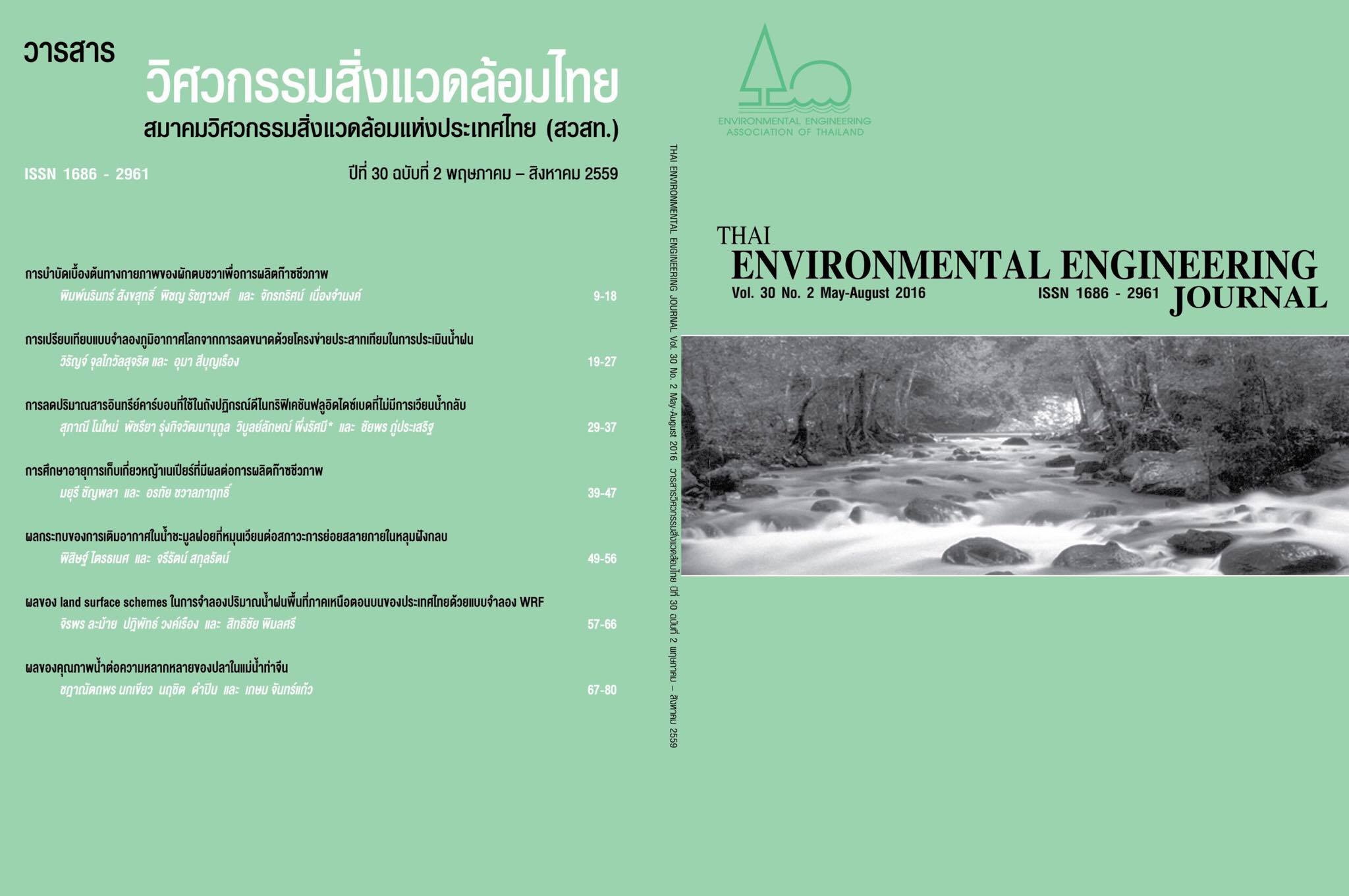Physical Pretreatment of Water Hyacinth for Biogas Production
Main Article Content
Abstract
The objective of this work was to study the effect of physical pretreatment of water hyacinth by size reductionon biogas production and biogas production was estimated by biochemical methane potential (BMP). The BMP work was performed using 120-ml serum bottles. The ratio of water hyacinth to cow dung was 5:1 (wet weight). The six size ranges of water hyacinth were pretreated as: less than 5, 5-10, 10-15, 15-20, 20-25 and 25-30 mm. respectively, while the cow dung served as control. And compare the six size ranges with the size range of 40-50 mm. (no pretreatment). During 39-day incubation period within a room temperature range of 28.1 to 32.0oC, The steady state, the six size ranges and no pretreatment had methane percentages between 47.05 and 53.48. The average of daily biogas production was 18.52±10.80 ml. The biogas yield of water hyacinth with the size of less than 5 mm. was highest of 0.26 m3/kg VS. Furthermore, the size ranges of 5-10, 10-15, 15-20, 20-25 and 25-30 mm. had biogas yields of 0.25, 0.23, 0.21, 0.21 and 0.20 m3/kg VS, respectively. The overall results showed that pretreating Water Hyacinth by size reduction did statistically affect the volume of cumulative biogas produced (Sig <0.05).
Article Details
References
[2] Department of Alternative Energy Development and Efficiency. 2015. Alternative Energy Development Plan: AEDP2015. [online]. Availble from : http://www.dede.go.th/main. php ? filename=index. (in Thai)
[3] Prime Minister’s Office. 2014. Quantity of water hyacinth in Thailand. [online]. Availble from: http://region2553. prd.go.th/prphayao/news. (in Thai)
[4] Verma, S. 2002. Anaerobic digestion of biodegradable organic in municipal solid wastes. Department of Earth & Environmental Engineering, Columbia University, USA.
[5] AOAC. 1991. Association of analytical communities. Maryland, USA.
[6] Van Soest, P.J., Robertson, J.B. and Lewis, B.A. 1991. Methods for dietary fiber, neutral detergent fiber and non-starch polysaccharides in relation to animal nutrition. J. Dairy Science. 74: 3583-3597.
[7] Sawyer, C.N., McCarty, P.L. and Parkin,
G.F. 2003. Chemistry for environmental engineering and science. 5th ed. New York, McGraw-Hill.
[8] Banks, C. 2007. D7: Kinetic data from a modified BMP test with uncoupling of solids and liquid retention times, Renewable energy from crops and agrowastes. School of Civil. Engineering & the Environment, University of Southampton, UK.
[9] Nigam, J.N. 2002. Bioconversion of water-hyacinth (Eichhornia crassipes) hemicellulose acid hydrolysate to motor fuel ethanol by xylose–fermenting yeast. J Biotechnol. 97: 107-116
[10] Pukdepin, A. 1988. Microbiological and chemical pretreatments of water hyacinth used as the substrate for biogas production. Master of Science. Kasetsart university. (in Thai)
[11] Charles, E. W., et al. 2005. Hydrolysis of Cellulose and Hemicellulose. 2nd ed. New York, Marcel Dekker.
[12] Ahn, H. K., Smith, M. C., Kondrad, S.L. and White, J. W. 2010. Evaluation of biogas production potential by dry anaerobic digestion of switchgrass-animal manure mixtures. Appl. Biochem. Biotech. 160: 965-975.
[13] Krathy, L. and Jirout, T. 2011. Biomass size reduction machines for enhancing biogas production. Chem. Eng. Technol. 34: 391-9.
[14] Gunnarsson, C. C. and Petersen, C. M. 2007. Water hyacinths as a resource in agriculture and energy production: A literature review. Waste Manage. 27: 117-129.
[15] Tuntulvate, M. 1999. Technology of induatrial wastewater treatment. Vol 1. 1st ed . Bangkok, Chulalongkorn university (in Thai)
[16] Rittmann, B. E. and McCarty, P. L. 2000. Environmental biotechnology: Principles and applications. New york, McGraw-Hill.


